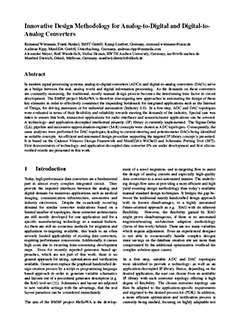
Abstract
- ADCs and DACs are vital in modern signal processing, connecting analog and digital domains.
- Growing demands make manual design a bottleneck; MeKoWA project aims to automate ADC and DAC design.
- Evaluation of ADC (Sigma-Delta, pipeline, SAR) and DAC (current-steering, potentiometer) topologies.
- Development of a technology- and application-decoupled IP library using Cadence Virtuoso and MunEDA’s tools.
- First silicon-verified results and demonstrators in progress for automated data converter IPs.
IP Porting
Today, high performance data converters are a fundamental part in almost every complex integrated circuit. They provide the required interfaces between the analog and digital domain for numerous applications such as medical imaging, communication infrastructure, automotive and industry electronics. Despite the ceaselessly recurring demand for similar converter realizations based on a limited number of topologies, these converter architectures are still mostly developed for one application and for a specific manufacturing technology in a manual fashion.
As there are still no economic methods for migration and application re-targeting available, this leads to an often severely limited applicability of existing data converters, requiring performance concessions. Additionally, it causes high costs due to recurring time-consuming development steps. Even for recently reported generator based approaches, which are not part of this work, there is no general approach for sizing, optimization and verification available.
Generators replace the graphical handcrafted design creation process by a script or programming language based approach in order to generate variable schematics and layouts out of a procedural generator description (e.g. the BAG tool-set [1]). Schematics and layout are adjusted to new variable settings with the advantage, that the real layout parasitics can be considered immediately.
For more information on this topic, send us a request
To get the selected information or request for a solutions demo please enter your data with the following form.